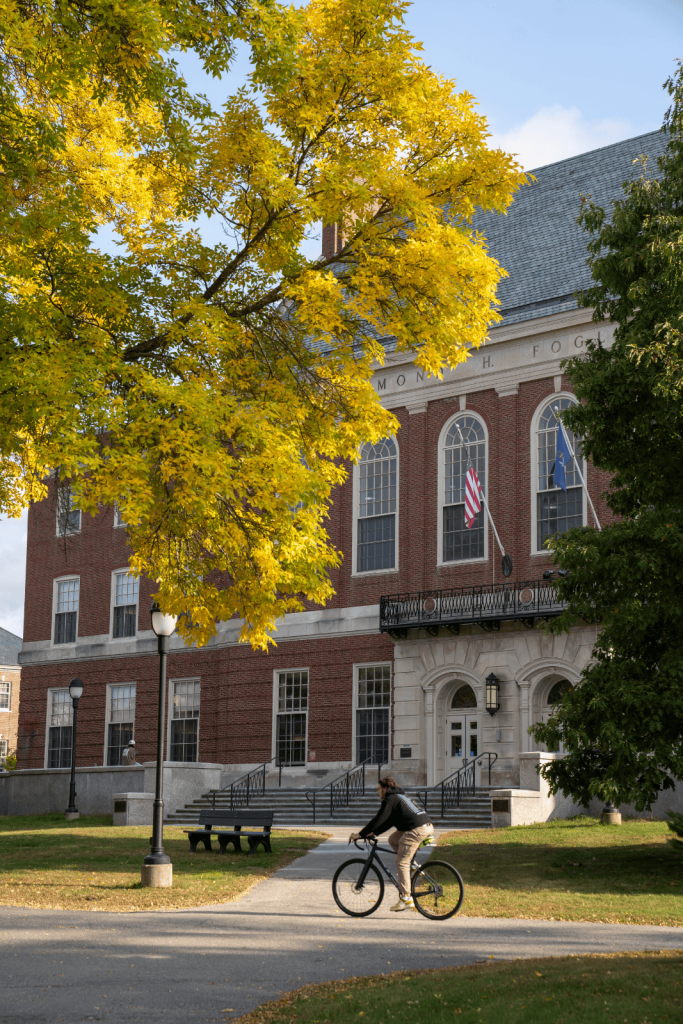History of Fogler Library
The Early Years
Sharing the building space with other academic departments was the norm in the early years of the campus library. In 1868 the campus had “the nucleus of a library” which was housed in a single room in Fernald Hall along with the chemical laboratory. Ezekiel Holmes, a proponent for Maine agriculture, and Abner Coburn, Governor and President of the Board of Trustees, were early benefactors.
By 1888, the library was moved to considerably larger quarters in Coburn Hall which had just been completed. The collection housed in two rooms then consisted of 4,000 volumes which for the first time were catalogued, classified and arranged to make them more readily available to the campus community. In 1890, Miss Harriet Converse Fernald became the first trained librarian at the college as the library headed into a “period of development” as it emerged from a “pioneer period.” The need for periodicals for the collection was recognized and by 1896 they numbered 97.
A course in Library Economy was introduced to the curriculum in 1894 and at this time the librarian recommended addressing the lack of literature books. From 1897 to 1905, the collection and usage by students and faculty grew significantly, requiring more space and more staff. Additional accommodations were found in Coburn when the university offices moved to Alumni Hall in 1900. By 1904, however, the continued growth required packing of seldom used materials and lack of shelving space was a critical issue. So it was in 1905 that the gift of $50,000 from Mr. Andrew Carnegie was well timed and led to building the first edifice whose primary purpose was to support library services at the college.
The Carnegie Chapter
Andrew Carnegie is widely known and appreciated for his contributions to the development of public libraries in the United States. Between 1893 and 1919 he and his corporation provided over $41 million to build 1,689 public libraries in the United States. By 1919, the year that the last grant was made, Carnegie had, in fact, built more than one half of all the public libraries in this country. What is less well known is that he also funded academic library buildings.
The University of Maine’s library building was one of 108 U.S. academic libraries built with funding from Andrew Carnegie and the Carnegie Corporation. As was the case with public libraries, by 1910 Carnegie had funded the construction of over one half of the total number of the college libraries ever built in the U.S. Carnegie Hall on the University of Maine Orono campus is one of Maine’s five academic and 18 public “Carnegie libraries.”
Present and Future
By 1939, the student body (1,929) and the library’s collection (136,000 volumes) had outgrown the capacity of Carnegie Hall. Expanding Carnegie Hall was considered impractical, so a fundraising campaign was launched to finance a new, larger library building. This new facility would provide more space, including areas for special gift collections, student study rooms, and fireproof protection. The campaign opened on February 25, 1940, at the 75th anniversary of Founders Day and was concluded in 1941. 5,936 alumni, students, faculty, and friends raised $251,553 towards the costs of the “New Library” as it was known. Norman H. Mayo (Class of 1909), served as chair of the campaign. In 1943, Raymond H. Fogler (Class of 1915) became chair of the Library Fund Committee.
Ground was formally broken for the “New Library” during commencement, 1941, but World War II delayed completion of the building until 1947. The stack capacity provided was estimated to be 250,000 volumes, with space available for an additional 200,000 as needed. The library had a seating capacity of 600. Included in the plans were space for a main reading room; a University of Maine room for historical materials and books by University of Maine graduates; a state of Maine room for books by Maine authors and town histories; a periodicals room for current magazines and newspapers; a special collections room for gifts made to the university; and seminar rooms.
In 1962, the building was named after Raymond H. Fogler (Class of 1915) for his services to the University of Maine. In 1963, the library became a regional depository site for government documents and a new addition was soon in order and completed in 1976 to accommodate a further 250,000 volumes. In 1995, the Library Annex was built on the south end of campus and half of the space committed to storage before the doors opened in early 1996. Climate control in this new facility enabled the university to compete successfully for the Cohen Archives which are housed there along with selected Special Collections materials, government documents, early Dewey classed monographs, and pre-1936 periodicals.
In 2004, the Fogler Library Steps and Terrace Renovation project led to a $900,000 improvement of the library’s steps and terrace. A dedication ceremony for the newly renovated area took place during the 2004 Alumni Reunion.
Today, the library’s collections consist of over 1.3 million print volumes and provides access to 1.7 million ebooks and digital government documents, 175,000 online serials, 351 online research databases, 823,000 physical media, 313,000 digital media titles, and 73,000 holdings in the library’s Institutional Repository. With the rapidly changing needs of our faculty and students, the library continues to explore and offer a variety of technology and services geared toward the digital age.

Share Your umaine libraries Story!
Did Fogler Library shape your student experience? Did you find a favorite study spot at Merrill? Discover research tools through Maine InfoNet, publish with the University of Maine Press, or make a lifelong connection through the library?
We’d love to hear your story. Share your UMaine Libraries experience and you may be featured on our website or social media.
